

This short article describe auto-loading pistols utilize by heros
and vilains of the Justice Inc. universe.
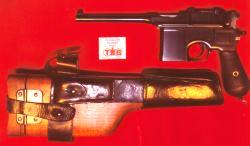 One
of the most distinctive handguns ever produced, the Bromhandle Mauser first
appeared in 1896 and was constantly improved as time went on (for game
purposes the stat rest the same as the original model).
One
of the most distinctive handguns ever produced, the Bromhandle Mauser first
appeared in 1896 and was constantly improved as time went on (for game
purposes the stat rest the same as the original model).
The "Bromhandle" is so called du to its slender grip that does not house ammunition. Rather, the magazine well is located forward of the trigger guard. It was never the official sidearm of a major nation, but was used in just about every war of the 20th century. One accessory available with the bromhandle was a combination shoulder stock holster (+1 range level). And finalely some were manufactured as selected fire weapons (autofire 5) with a 20 shots detachable magazine box and wich could be used in conjonction with the shoulder stock as a submachine gun. In the 1920 and 1930 they are used mostly by law enforcement personnel and security troops.
OCV: +1 RMOD: 0 DAM: 1D6(3 DC) STUNX: 1D6-1 SHOTS: 10 STR MIN: 10 PER MOD: +3
NOTES: SEE TEXT.
 The Kolibri is the smallest semi-automatic ever commercially produced.
Designed as a ladies gun, it weights a mere two and one half ounces. The
magazine holds seven of the tiny 2.7 mm centerfire cartridges. It is pictured
here with a .45 caliber round to demonstrate its small size.
The Kolibri is the smallest semi-automatic ever commercially produced.
Designed as a ladies gun, it weights a mere two and one half ounces. The
magazine holds seven of the tiny 2.7 mm centerfire cartridges. It is pictured
here with a .45 caliber round to demonstrate its small size.
OCV: -2 RMOD: -2 DAM: 0.5D6(2 DC) STUNX: 1D6 SHOTS: 7 STR MIN: 5
PER MOD: -1
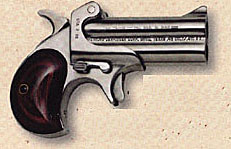 The Remington double-derringer is the gambler's companion from it's introduction
in 1886 to 1935 when Remington ended its production. It has double-decker
3-inch barrels of .41, a pretty anemic rounds, but it was better than nothing
in a pinch.
The Remington double-derringer is the gambler's companion from it's introduction
in 1886 to 1935 when Remington ended its production. It has double-decker
3-inch barrels of .41, a pretty anemic rounds, but it was better than nothing
in a pinch.
OCV: -1 RMOD: -1 DAM: 0.5D6(2 DC) STUNX: 1D6-1 SHOTS: 2 STR MIN:
5 PER MOD: 0
 The
browning baby is one of the smallest representative of the most widespread
kind of pistol in the world. John Browning designed the 25 ACP cartridge
(called the 6.35mm in Europe) in 1905. They were an immediate success with
people who wanted to be unobstrussively armed; these tiny flat pistol are
very easy to hide. The usual professional opinion is that they are nice
to have if you can't carry a gun or used them as last-ditch weapon.
The
browning baby is one of the smallest representative of the most widespread
kind of pistol in the world. John Browning designed the 25 ACP cartridge
(called the 6.35mm in Europe) in 1905. They were an immediate success with
people who wanted to be unobstrussively armed; these tiny flat pistol are
very easy to hide. The usual professional opinion is that they are nice
to have if you can't carry a gun or used them as last-ditch weapon.
OCV: +0 RMOD: -2 DAM: 0.5D6(2 DC) STUNX: 1D6-1 SHOTS: 6 STR MIN:
5 PER MOD: +0
 This
widely produced belgian handgun sold well on the commercial market and
was manufactured and widely copied all over the world. Available in 32
ACP and 380 ACP calibers, it is a semi-automatic pistol using a detachable
six-shots box magazine. It was widely used in Europe as a law enforcement
weapon and saw limited use as a second line weapon in military hands. For
the vilain's goons if europeen it is the mandatory handgun.
This
widely produced belgian handgun sold well on the commercial market and
was manufactured and widely copied all over the world. Available in 32
ACP and 380 ACP calibers, it is a semi-automatic pistol using a detachable
six-shots box magazine. It was widely used in Europe as a law enforcement
weapon and saw limited use as a second line weapon in military hands. For
the vilain's goons if europeen it is the mandatory handgun.
OCV: 0 RMOD: -1 DAM: 1D6(3 DC) STUNX: 1D6-1 SHOTS: 8 STR MIN: 8 PER
MOD: +1
 Firts
appearing in 1925, it is a semi-automatic 8mm pistol that is a modified
version of the M1904 pistol. It was acceptep as the standard Japanese service
pistol and saw combat service in Mandchuria. The Nambu type 14 superficially
is similar in appearance to the German P08 Luger, but is not known for
being a high quality weapon. One important problem with it involves changing
its 8 round magazine. If the weapon is not well maintened and the user's
hands are not dry, it is sometimes difficult to remove the magazine. In
1939, a modified version with an enlarged trigger guard appeared. This
was for use in cold weather when the shooter would probably be wearing
heavy gloves.
Firts
appearing in 1925, it is a semi-automatic 8mm pistol that is a modified
version of the M1904 pistol. It was acceptep as the standard Japanese service
pistol and saw combat service in Mandchuria. The Nambu type 14 superficially
is similar in appearance to the German P08 Luger, but is not known for
being a high quality weapon. One important problem with it involves changing
its 8 round magazine. If the weapon is not well maintened and the user's
hands are not dry, it is sometimes difficult to remove the magazine. In
1939, a modified version with an enlarged trigger guard appeared. This
was for use in cold weather when the shooter would probably be wearing
heavy gloves.
OCV: +1 RMOD: 0 DAM: 1D6(3 DC) STUNX: 1D6-1 SHOTS: 8 STR MIN: 8 PER MOD: +1
NOTES: MAGAZINE JAM ON 10-.
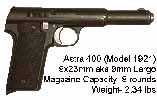 Based
on the Campo-Giro M1913-16 pistol, the M1921 is a definite improvement.
It is unique for one very important reason: it can chamber and fire most
major form of 9mm pistol ammunition (9mm Largo, Parabellum, Glisenti, 9mm
Browning long as well as 38 super auto and 380 ACP). From the point of
view of logistics, this makes it a very handy pistol for a Justice Inc.
adventurer. It was produced commercially under the designation Astra 400
and the Spanish Army was a major user of it. A later variant is worthy
of note. A selective fire version known as the model M was manufactured
in the 1930s in 45 ACP caliber.
Based
on the Campo-Giro M1913-16 pistol, the M1921 is a definite improvement.
It is unique for one very important reason: it can chamber and fire most
major form of 9mm pistol ammunition (9mm Largo, Parabellum, Glisenti, 9mm
Browning long as well as 38 super auto and 380 ACP). From the point of
view of logistics, this makes it a very handy pistol for a Justice Inc.
adventurer. It was produced commercially under the designation Astra 400
and the Spanish Army was a major user of it. A later variant is worthy
of note. A selective fire version known as the model M was manufactured
in the 1930s in 45 ACP caliber.
OCV: 0 RMOD: 0 DAM: 1D6/1D6+1(3/4 DC) STUNX: 1D6-1 SHOTS: 8 STR MIN: 8 PER MOD:+2
NOTES: AF:5 FOR THE MODEL M.
 The
P38 is a reliable 9mm pistol that is easy to shoot and maintain. It was
supposed to completely supplant the Luger and was certainly a superior
design, both from the standpoint of reliability and cost and ease of mass
production. This pistol is the weapon of choice for the NAZIES goons and
the probality are high the adventurers are to dodge its lethal firepower.
The
P38 is a reliable 9mm pistol that is easy to shoot and maintain. It was
supposed to completely supplant the Luger and was certainly a superior
design, both from the standpoint of reliability and cost and ease of mass
production. This pistol is the weapon of choice for the NAZIES goons and
the probality are high the adventurers are to dodge its lethal firepower.
0CV: +1 RMOD: 0 DAM: 1D6+1(4 DC) STUNX: 1D6-1 SHOTS: 8 STR MIN: 9
PER MOD: +2
 The
earliest Lugers were actually produced in Switzerland in 1900, but it became
famous as a 9mm weapon in WWI where it served in Germany alongside the
famous Broomhandle Mauser. A comfortable pistol to hold and shoot, Its
main drawback is its suceptibility to the harsh and filthy conditions of
the battlefield. In spite of this, it remained popular and provided excellent
service. This weapon is a perfect companion for a vilain with a aristocratic
bend or for the mastermind of the scenario.
The
earliest Lugers were actually produced in Switzerland in 1900, but it became
famous as a 9mm weapon in WWI where it served in Germany alongside the
famous Broomhandle Mauser. A comfortable pistol to hold and shoot, Its
main drawback is its suceptibility to the harsh and filthy conditions of
the battlefield. In spite of this, it remained popular and provided excellent
service. This weapon is a perfect companion for a vilain with a aristocratic
bend or for the mastermind of the scenario.
OCV: +1 RMOD: 0 DAM: 1D6+1(4 DC) STUNX: 1D6-1 SHOTS: 8 STR MIN: 9 PER MOD: +2
NOTES: A SHOULDER STOCK (RMOD: +1) AND SNAIL MAGAZINE 33 ROUND ARE
DISPONIBLE WITH THE ARTILLERY LUGER.
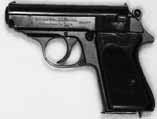 In
1929, Walther introduced a then-radical design, a double-action-firts-shot
auto-loading pistol. They called-it the PP (Polizei Pistolen or police
pistol). In 1931, a slightly modified version was introduced under the
name PPK (Polizei Pistolen Kriminal, implying that it was for plain-clothes
officers). They were favorites of the Nazi hierarchy and are often found
in elaborately engraved and decorated versions, with pearl or ivory stocks.
They were also fabricated in 380 ACP caliber.
In
1929, Walther introduced a then-radical design, a double-action-firts-shot
auto-loading pistol. They called-it the PP (Polizei Pistolen or police
pistol). In 1931, a slightly modified version was introduced under the
name PPK (Polizei Pistolen Kriminal, implying that it was for plain-clothes
officers). They were favorites of the Nazi hierarchy and are often found
in elaborately engraved and decorated versions, with pearl or ivory stocks.
They were also fabricated in 380 ACP caliber.
OCV: +1 RMOD: -1 DAM: 1D6(3 DC) STUNX: 1D6-1 SHOTS: 7 STR MIN: 7
PER MOD: +1
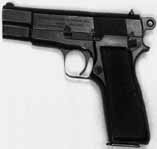 The
Browning Grande Puissance (high-power) was commercially introduced by the
Fabrique Nationale organization at Herstal, Belgium in 1935. This pistol
was the predecessor of the high-capacity 9 mm pistols thats become popular
in ours modern day. A magazine capacity of 13 round is a big advantage
in the 30s for a Justice Inc. adventurer. The magazine capacity of other
pistol of this time vary between 5 for the less or 10 for the most, a advantage
in the worse situation of 3 shots.
The
Browning Grande Puissance (high-power) was commercially introduced by the
Fabrique Nationale organization at Herstal, Belgium in 1935. This pistol
was the predecessor of the high-capacity 9 mm pistols thats become popular
in ours modern day. A magazine capacity of 13 round is a big advantage
in the 30s for a Justice Inc. adventurer. The magazine capacity of other
pistol of this time vary between 5 for the less or 10 for the most, a advantage
in the worse situation of 3 shots.
OCV: 0 RMOD: 0 DAM: 1D6+1(4 DC) STUNX: 1D6-1 SHOTS: 13 STR MIN: 7
PER MOD: +2
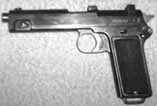 The
Steyr-Hahn (hahn is German for hammer) pistol was first produced in 1911
with a fixed blade front sight, the model M11. It is an 8 shot top loader
that is stripper fed, shooting the 9mm Steyr cartridge. The model M12 with
dovetailed front sight was adapted by the Austrian army in (surprise) 1912.
The gun was mass produced until 1919 although it is belived that many were
assembled from parts for several years thereafter. The Romanian Police
used the Steyr-Hahn and that version bears a Romanian crest. The Chilean
army adopted the 1911 and that model bears a crest also. A few Steyr-Hahn
M16 in full auto with extanded magazines were used in WWI and by early
Austrian Nazis. Its a ideal weapon for a South America goons or for their's
leader Maximo.
The
Steyr-Hahn (hahn is German for hammer) pistol was first produced in 1911
with a fixed blade front sight, the model M11. It is an 8 shot top loader
that is stripper fed, shooting the 9mm Steyr cartridge. The model M12 with
dovetailed front sight was adapted by the Austrian army in (surprise) 1912.
The gun was mass produced until 1919 although it is belived that many were
assembled from parts for several years thereafter. The Romanian Police
used the Steyr-Hahn and that version bears a Romanian crest. The Chilean
army adopted the 1911 and that model bears a crest also. A few Steyr-Hahn
M16 in full auto with extanded magazines were used in WWI and by early
Austrian Nazis. Its a ideal weapon for a South America goons or for their's
leader Maximo.
OCV: +1 RMOD: 0 DAM: 1D6+1(4 DC) STUNX: 1D6-1 SHOTS: 8 STR MIN: 5 PER MOD: +2
NOTES: THIS WEAPON IS A CLUMSY HAMMER BUT A UTILISABLE ONE (+1D6
HAND ATTACK).
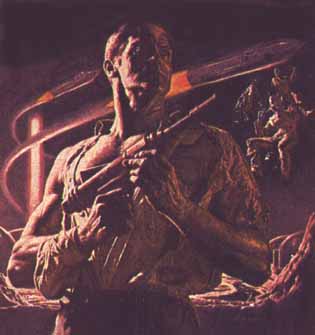 The mercy gun was developed by an American adventurer and inventor, Clark
Savage Jr, who hesitates to takes human life. He has, therefore, developed
a machine pistol wich can fire commercial .45 ACP ammo or small rubber
bullets wich contain an aneasthetic subtance. The gun may be fired single-shot
or full autofire. Two version exist: the original and the re-engineered
model. The original is larger than a Colt .45 1911A1 and has a 20-shots
clip. The reworked model is more larger than the original and has a a 40-shots
clip and fire single-shot or full autofire 5 or 10. The two model also
produce a curious sound when fired full-auto, the sound of a giant violin
played with an infernal speed. The Mercy Gun is not in commercial production,
and never will be. Perhaps it's a gift for a past favor done by the PC
to Doc Savage.
The mercy gun was developed by an American adventurer and inventor, Clark
Savage Jr, who hesitates to takes human life. He has, therefore, developed
a machine pistol wich can fire commercial .45 ACP ammo or small rubber
bullets wich contain an aneasthetic subtance. The gun may be fired single-shot
or full autofire. Two version exist: the original and the re-engineered
model. The original is larger than a Colt .45 1911A1 and has a 20-shots
clip. The reworked model is more larger than the original and has a a 40-shots
clip and fire single-shot or full autofire 5 or 10. The two model also
produce a curious sound when fired full-auto, the sound of a giant violin
played with an infernal speed. The Mercy Gun is not in commercial production,
and never will be. Perhaps it's a gift for a past favor done by the PC
to Doc Savage.
OCV: +1 RMOD: +0 DAMAGE: 1D6+1 STUNX: 1D6 SHOTS: 20/40 STR MIN: 12 PER MOD: +3/+4
NOTES: AF: 5/5 OR 10. fIRING THE MERCY BULLETS, THE GUN DOES 1 POINT
OF KILLING DAMAGE PER BULLET; IF THE POINTS GETS THROUGHT THE ARMOR, THE
BULLETS DOES 4D6 NND (A MERCY BULLET STRIKING AN ARMORED AREA IS COMPLETELY
USELESS).
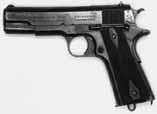 Firts
adopted by the military in 1911 this popular handgun is available in two
versions: the M1911, and the M1911A1, virtually identical except for the
A1's grip safety, making it safer to carry. Millions of this pistol have
been manufactured around the world, serving in numerous wars as well as
the law enforcement and civilian sectors. Using the powerfull .45 ACP round,
this gun has excellent stopping power. It has a seven-round detachable
box magazine that loads into the grip. This gun was the trusted companion
of the more famous vigilante of the era: The Shadow and The Spyder. For
numerous vilains their last sighting was the smoke of the barrel of theirs
twin .45 auto.
Firts
adopted by the military in 1911 this popular handgun is available in two
versions: the M1911, and the M1911A1, virtually identical except for the
A1's grip safety, making it safer to carry. Millions of this pistol have
been manufactured around the world, serving in numerous wars as well as
the law enforcement and civilian sectors. Using the powerfull .45 ACP round,
this gun has excellent stopping power. It has a seven-round detachable
box magazine that loads into the grip. This gun was the trusted companion
of the more famous vigilante of the era: The Shadow and The Spyder. For
numerous vilains their last sighting was the smoke of the barrel of theirs
twin .45 auto.
OCV: +1 RMOD: +0 DAM: 1D6+1(4 DC) STUNX: 1D6 SHOTS: 7 STR MIN: 9
PER MOD: +2
 Historically
overshadowed by Savage rifle making enterprises from the late 1800, this
little handgun was one of the most popular pistol of his era. The operational
design was taken from Savage Arms Company's .45 caliber entry into the
1905 U.S. military handgun trials. From 1907 to 1926 this small American
semi-automatic pistol brought comfort and security to American citizens.
Offered in .32 and .380 calibers, it's unique no screws, no tools, design
outsold Colt and its rivals every year until the onset of WWI. It provided
to man and woman with personal carry protection through tumultuous times
following WWI and 1920s-era gangsters. It's rugged high capacity magazine...
10 quick shots was their motto... higher muzzle velocity and reliability
to shoot faster that it's competitor placed it in hundreds of thousands
of AMERICAN homes.
Historically
overshadowed by Savage rifle making enterprises from the late 1800, this
little handgun was one of the most popular pistol of his era. The operational
design was taken from Savage Arms Company's .45 caliber entry into the
1905 U.S. military handgun trials. From 1907 to 1926 this small American
semi-automatic pistol brought comfort and security to American citizens.
Offered in .32 and .380 calibers, it's unique no screws, no tools, design
outsold Colt and its rivals every year until the onset of WWI. It provided
to man and woman with personal carry protection through tumultuous times
following WWI and 1920s-era gangsters. It's rugged high capacity magazine...
10 quick shots was their motto... higher muzzle velocity and reliability
to shoot faster that it's competitor placed it in hundreds of thousands
of AMERICAN homes.
OCV: +1 RMOD: 0 DAMAGE: 1D6(3DC) STUNX: 1D6-1 SHOTS: 10 STR MIN:
7 PER MOD: +1
 The gaz gun was conceived and invented by Kato the side-kick of the Green
Hornet. This weapon is extremely efficient piece of techology. It was conceived
with in mind the task of eliminating the Green Hornet adversaries without
arming or killing them. Constructed with the frame of a Mauser C.96, this
weapon has only three shots. The gaz tank is situed under the barrel and
his pleinly visible. The Green Hornet Gaz-Gun in AVI.
The gaz gun was conceived and invented by Kato the side-kick of the Green
Hornet. This weapon is extremely efficient piece of techology. It was conceived
with in mind the task of eliminating the Green Hornet adversaries without
arming or killing them. Constructed with the frame of a Mauser C.96, this
weapon has only three shots. The gaz tank is situed under the barrel and
his pleinly visible. The Green Hornet Gaz-Gun in AVI.
OCV: +1 RMOD: -1 DAM: 5D6 NND (GAZ MASK) SHOTS: 3 STR MIN: 10 PER
MOD: +3 PRICE: PRIVATE PRODUCTION NOT AVAILABLE.
 In 1930 Fyodor Tokarev
produced a pistol chambered for the 7.62x25mm cartridge which is perceived
to be a modification of the .30 Mauser cartridge (7.65x25mm). This pistol
was adopted as the standard sidearm for Russian troops.
In 1930 Fyodor Tokarev
produced a pistol chambered for the 7.62x25mm cartridge which is perceived
to be a modification of the .30 Mauser cartridge (7.65x25mm). This pistol
was adopted as the standard sidearm for Russian troops.
In 1933 the pistol was replaced by the TT33 model which was a 1930 continuing
design effort of Tokarev. Tula is a city in Russia which is the largest
handgun manufacturing area in that country. The Tula-Tokarev TT33 design
is generally perceived in America to borrow heavily from John M. Browning's
designs of the early 1900's. In any case the result is currently known
as the Tokarev and is frequently found in 7.62 Tokarev (7.62x25mm) and
in 9mm Parabellum (9x19mm).
OCV: +1 RMOD: -1 DMG: 1D6+1 (4 DC) PER MOD:
+2 STUN X: 1D6 STR: 8 SHOTS: 8
NOTES: RED ARMY SIDEARM
 This automatic
pistol manufactured in 380 and 7.65 calibers by FN in Belgium, is an evolution
of the Browning 1910. It possesses a magazine with two more shots
than its predecessor and a longer barrel for a better precision. The model
1922 size renders it more difficult for conceal purpose but the hammerless
design renders it easier to draw that most pistol. This handgun is
massively employed by the armies,polices and criminals of Europe.
On the continent Browning is synonymous of pistol as Winchester is synonymous
with rifle to USA.
This automatic
pistol manufactured in 380 and 7.65 calibers by FN in Belgium, is an evolution
of the Browning 1910. It possesses a magazine with two more shots
than its predecessor and a longer barrel for a better precision. The model
1922 size renders it more difficult for conceal purpose but the hammerless
design renders it easier to draw that most pistol. This handgun is
massively employed by the armies,polices and criminals of Europe.
On the continent Browning is synonymous of pistol as Winchester is synonymous
with rifle to USA.
OCV: +1 RMOD: 0 DAM:1D6(3DC)
STUNX: 1D6-1 SHOTS: 10
STR MIN: 8 PER MOD: +2 NOTES: +1 FAST DRAW.

OCV: +1 RMOD: +0 DAM: 1D6K(4DC) STUNX: 1D6-1 SHOT: 8
STR MIN: 8 PER MOD: +2 NOTES: SHOULDER STOCK (+1 RMOD)